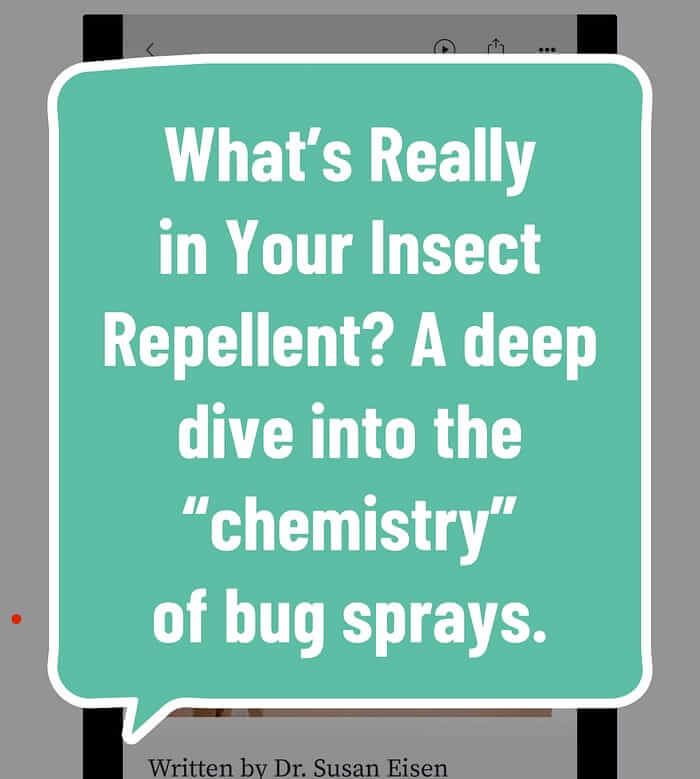
What’s really in your insect repellent? Or maybe the better question is are you even using an insect repellent? And are they all the same? Are the chemical (synthetic) sprays better and are they really safe? Are the natural repellents as good and do they really work? Are all natural repellents the same?
These are lots of questions to sift through and I will attempt to answer all of them with a deep dive into the “chemistry” of insect repellents for use on the skin.
The first question you might have is Why do I even need to use an insect repellent? Aren’t they poisonous? The simple answer here is it is what is in the formula of your insect repellent that factors into a potential toxicity. Not all formulas are identical and not all sprays contain the same ingredients.
First, we have the synthetic chemical brands that contain DEET or permethrin and picaridin; all synthetically derived and all potentially hazardous.
The second part of this involves the why. With the increase of temperatures on our planet, the need for a safe, reliable bug spray has become as essential as having a toothbrush or a hairbrush or soap in your daily hygiene. Vector borne tropical diseases (from bug bites) are exploding as well as other infectious diseases that have been around for millennia. Simply put, there are more bugs carrying disease producing pathogens.
With this we have seen an increase in natural repellents as well as an increased push by the CDC to use synthetic chemical repellents. All said, it is good that people are beginning to understand the need for protection as a simple bug bite can now cost you the quality of your life for an undetermined amount of time.
This led us to wonder. What’s really in your insect repellent? Is is safe? Is it effective?
The active ingredients in most chemical bug sprays are DEET, permethrin and picaridin. We are told that these synthetic chemical repellents that are the active ingredient in most chemical bug sprays are long lasting 8–12 hours and therefore the best. The question to be answered here… are they really safe? DEET is a strong neurotoxin and causes a variety of side effects including seizures. Permethrin is a known human carcinogen. Do we really want to be putting these harmful ingredients on our skin and on our pets during the hot summer months when everything melts in our sweat and gets into our eyes and mouths? The incidence of cancer and seizures in our dogs has been steadily increasing year after year.
From Consumer Reports: “Permethrin disrupts the endocrine system and should not be inhaled. Applying it to the skin is safe when treating temporary conditions such as scabies, but it should not be applied repeatedly, such as to prevent mosquito or tick bites.”
Permethrin is the main ingredient in NIX shampoo for lice. The instructions specifically state not to use it more than one time, so why is it okay to use it several times daily in our insect repellents?
Now let’s discuss natural repellents. They are plant based, nontoxic and have a much better record of safety for children and pets as well as adults. They utilize essential oils in a carrier oil or waxy base. Like food, it’s important to consider the quality of ingredients in personal care products and insect repellents are no exception to this rule. Organic and nonGMO are important considerations.
Most natural repellents claim to be waterproof which sounds like a good thing. The problem is that in order to blend the mixture, alcohol, witch hazel and other additives must be used that can reduce the effectiveness per application to 30–90 minutes depending on the brand. If you’re out on a long hike or in your backyard, it’s important to have a repellent that you don’t need to apply every hour. While waterproof sounds great, it’s less effective and doesn’t last as long.
A non waterproof insect repellent can be a better option because it doesn’t require any added ingredients to blend and the bioactivity of the active aromatic essential oils remains intact thus lasting much longer than the waterproof repellents. Look for products that are 100% oil based without drying agents. Also a non waterproof or hydrophilic blend adheres to the skin much better for greater coverage and can last 4–5 hours per application. There are very few repellents of this type on the market. One such brand is Tick Tock Naturals which was specifically formulated to be hydrophilic. It is clean, plant based and eco-friendly.
To summarize, tick season is here, and each season is getting more intense so it’s essential to protect yourself. Be careful with the products you put on your skin and make sure to research brands beyond supermarket shelves.